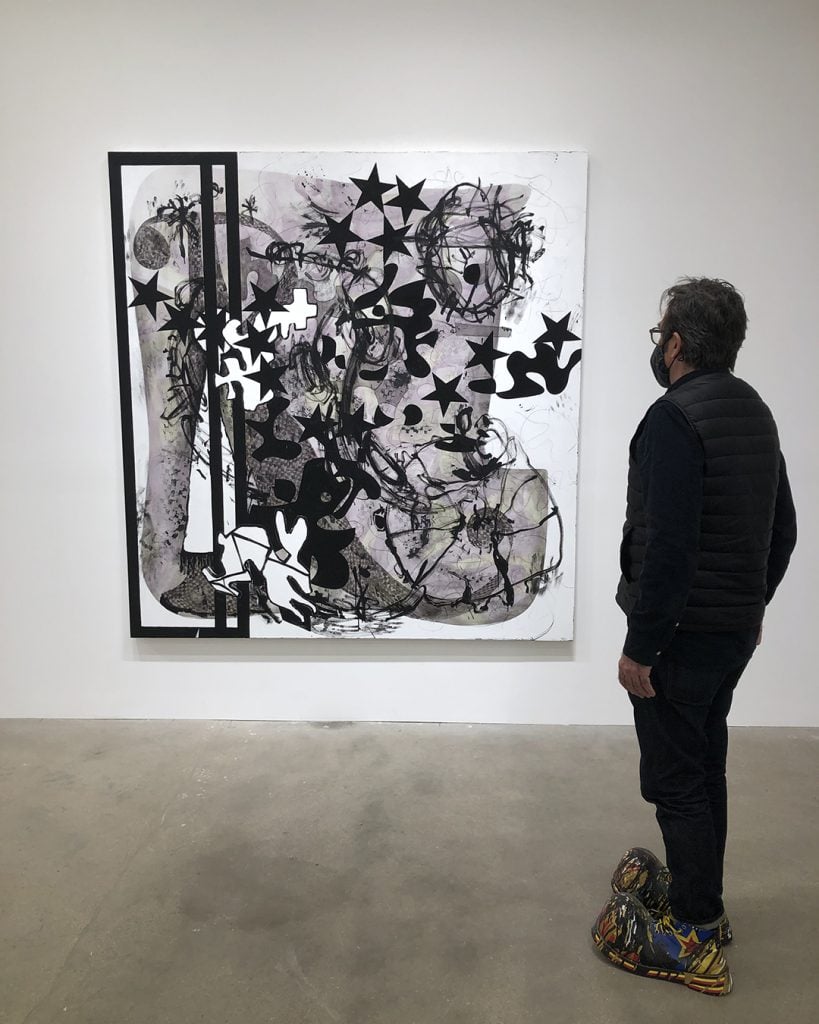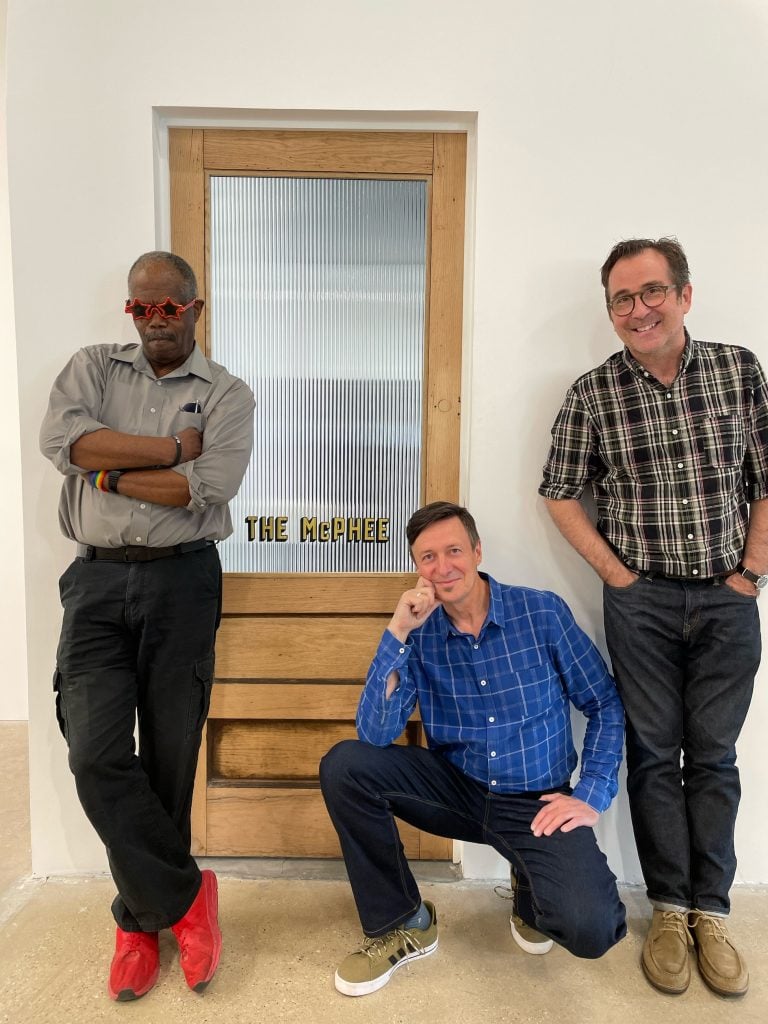Art World
Stalwart Chicago Gallery Corbett vs. Dempsey Celebrates 20 Years with Art, Music, and a New Partner
'They’re deeply smart, deeply committed, and deeply connected,' says one art fair director.

'They’re deeply smart, deeply committed, and deeply connected,' says one art fair director.

Brian Boucher

In their respective heydays, boxers James J. Corbett and Jack Dempsey ranked as World Heavyweight Champion, so when John Corbett and Jim Dempsey resolved to start an art gallery in Chicago, the handle Corbett vs. Dempsey must have seemed like a no-brainer. Today, the dealers run a program that has brought Midwestern artists to the attention of the wider world while bringing global artists to Chicago, sometimes for their first gallery outing there. In the process, they have become heavyweights in their own right, bringing what Expo Chicago director Tony Karman calls “cultural gravitas” to the sale of art.
CvsD, as the business styles itself, is currently in the midst of a celebration of its two decades in business. Asked by phone whether he ever expected to mark such an occasion, Corbett bluntly said, “No. I did not. But I also didn’t think about it. You put your arms forward and you walk.” The festivities includes a group show, “Hubcap Diamond Star Halo,” named for a lyric from the 1971 T. Rex hit “(Bang a Gong) Get it On,” that includes artists who have a history with the gallery, like Brian Calvin, Charline von Heyl, Rebecca Morris, Albert Oehlen, Karl Wirsum, and Christopher Wool.
Concurrently, CvsD is midway through staging seven shows in seven weeks that focus on the dealers’ ongoing fascinations, like musician-artists and Chicago art history. The third installment, the group show “Weird Old Chicago,” runs October 1-5. As if that weren’t enough, it is hosting a variety of events, including musical performances and a Christopher Williams record launch; still to come are a conversation between Corbett and von Heyl and a launch party for a memoir by jazz musician Joe McPhee.

Installation view of Rebecca Morris’s exhibition “#29” at Corbett vs. Dempsey, 2022. Photo: Robert Chase Heishman.
When they met in 2004, Corbett was teaching at the School of the Art Institute of Chicago (SAIC), and Dempsey was an art student there, but both had interests outside visual art. Corbett ran the Unheard Music Series record label (and still writes about experimental music), and Dempsey was working at an art house movie theater. Organizing a film festival on artist-musician Sun Ra, he asked Corbett for assistance, and their partnership grew when Corbett, in turn, invited Dempsey to help curate some shows at SAIC.
The two soon started to kick around the idea of starting a gallery to show Chicago artists, driven in part by a nagging question: Why, as lifelong Chicagoans, did they know so little about Chicago art?
They were met with skepticism from friends and family. Artist Richard Hull asked, “Did you fall on your head?”
On one early mission, they rented a truck to go to New York and pick up some work, listening on repeat to Terry Allen’s song “Truckload of Art,” in which a haul of avant-garde creations goes up in smoke when the driver crashes and dies. “You tempt fate by calling your business a fight,” Corbett said, “and then you tempt fate again by playing a song like that.”

John Corbett and Emily Letourneau at Art Basel, 2019. Photo: Jim Dempsey.
They first set up shop in a tiny plumbing supply shed on the North Side that, Corbett said, no one ever visited because they never told anyone about it. Next, they moved to a 3,000-square-foot space in Wicker Park, above the Dusty Groove record store, where they stayed for 15 years. Now, they and their team of six are in an 8,000-square-foot location on Fulton Street in Kinsey Corridor, and they’ve recently made longtime staffer Emily Letourneau a partner.
Early shows planted a regionalist flag: their debut was of Works Progress Administration–era Chicago cityscapes by artist Eve Garrison, followed by an exhibition of Chicago Imagists. The next year, they characteristically mixed disciplines with “Eye & Ear: Musician/Artist,” with crossover figures from Sun Ra to Sam Prekop (who’s known for his solo work as well as his recordings with post-rock band the Sea and Cake).
But, perhaps testifying to a Midwestern modesty, even as they began to notch some wins, like their first significant sale, Dempsey’s father told him, “Don’t bend over or that horseshoe will fall out of your ass.”
Wary of being pigeonholed, they didn’t want to only show Chicago artists to Chicagoans, so they turned their gaze outward. A turning point came with the 2009 show “Albert Oehlen: A Vanguard with Decorum,” which was the German’s first commercial showing in the city.

Installation view of David Hartt’s exhibition “The Histories (Old Black Joe)” at Corbett vs. Dempsey in 2020. Photo: Robert Chase Heishman.
“That was a watershed moment for us for a variety of reasons,” Corbett said. He had first met Oehlen in Chicago in 1989, when the artist was in a show with Georg Herold and Christopher Wool at the Renaissance Society. Oehlen appeared on a radio show Corbett was hosting, and he later provided cover art for some records released by a label where Corbett was working.
When Corbett and Dempsey asked Oehlen about being the first artist in an expanded program, the artist invited them to Spain to meet up. But when they arrived, Oehlen wasn’t there. His son had chicken pox and had been unable to get on the flight there, so he invited the dealers to his home in Switzerland. Corbett still chuckles at the memory of adding a leg to their trip. “We were not jet-setter types,” he said.
But the resulting show went well. It was “an entrée,” Corbett said. “Doing a show with him meant that other people thought, ‘If Albert is doing a show with them, that might be okay.’”
Another trademark exhibition followed the next year, with “Sound on Sound,” Christopher Wool’s first Chicago solo since 1986. While Wool is most closely associated with New York, he grew up in the Windy City’s Hyde Park area, and the show centered on the love for McPhee that Wool and the gallerists share. (The dealers actually refer to their office as the McPhee in his honor.)

Jim Dempsey with Charline von Heyl’s Thine Own Hare (2020). Shoes by Joyce Pensato. Photo: John Corbett.
Years later, the dealers maintain their enthusiasm for the interdisciplinary; Unheard Music Series operates under the gallery’s umbrella, and they regularly organize film screenings and musical performances at the gallery.
Talk to people who have worked with them in various capacities, and it doesn’t take long for genuine affection to emerge. Karman, the Expo head, attested to the dealers’ importance to the Windy City scene in a phone interview. (Besides exhibiting at the fair, Corbett and Dempsey also serve on its selection committee.)
“They’re deeply smart, deeply committed, and deeply connected to heralding and promoting and reinforcing Chicago artists, and not just current ones,” he said. “They really became the keeper of a lot of historic Chicago artists who are under-represented and under-shown, and have done that in ways that are super important for our city.” Because they both taught at SAIC, he said, generations of artists carry their imprint.

Joe McPhee, John Corbett, and Jim Dempsey at Corbett vs. Dempsey, 2019. Photo: Emily Letourneau.
The gallery is collaboration-minded, and took part in the space-trading Condo program. As part of Condo 2018, New York dealer Stefania Bortolami showed the painter Rebecca Morris on behalf of CvsD.
“I was aware of her work, but not until you live with it do you see how it grows on you, how you react to it, and I realized that I really loved it and started working with Rebecca,” Bortolami said. Condo is not an event where you go in hoping to add an artist to your roster, she said, but that’s exactly what happened.
“No one else has their taste,” the New York dealer said. Echoing Karman, she added, “They’re not strategic in terms of the market. I doubt that any decision was a market decision. They seem very sincere in that when they’re interested in an artist, whether they sell or not, they go for it.
“I always love Chicago because they’ve got a similar intellectual rigor and educational level as New York but without the cutthroat way of being that New Yorkers have,” she said. “I think they embody that really well. [London dealer] Thomas Dane and I were just talking about them. We wish there were more people like them!”